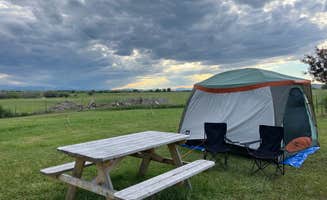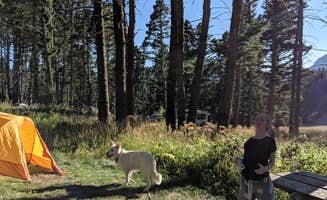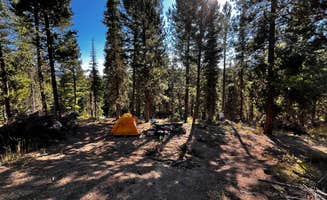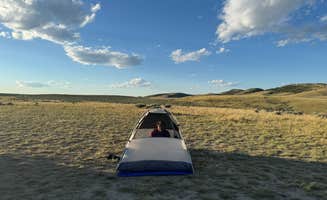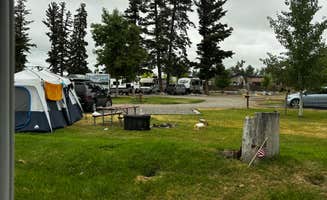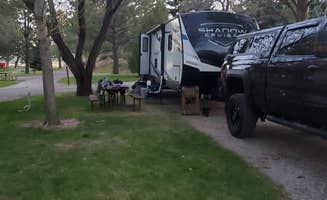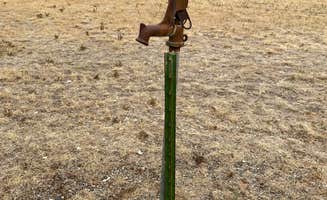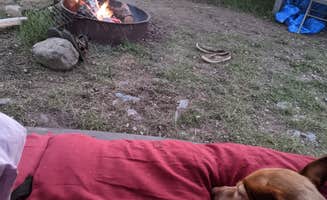Gallatin National Forest spans over 1.8 million acres in southwest Montana, with elevations ranging from 5,000 to 10,000 feet. Summer temperatures typically reach 70-85°F during the day, while nights often drop to 40-50°F even in summer months. Many campgrounds near Bridger and Fairy Lake areas remain snow-covered until late June, with high-country sites generally accessible from July through mid-September.
What to do
Hiking near Fairy Lake: Visitors can access the trailhead for Sacajawea Peak from Fairy Lake Campground. "The campground itself is small but well-maintained, with both tent and RV spots. The real highlight is the location—you're right at the spot where the Jefferson, Madison, and Gallatin Rivers come together to form the Missouri River," reports one camper.
Mountain biking at Copper City: The trail system offers routes for all skill levels with minimal shade. "Great spot right on parts of the trial! It's open and you can see miles in each direction. No shade, no bathrooms, but most have man made fire pits," notes a visitor at Copper City BLM.
Wildlife viewing: Animal sightings are common throughout the region, especially at higher elevations. "Mountain Goats will come in your camp and they will do what goats do and want to check you out. They are not scared," shares a camper who stayed at Fairy Lake.
Soak in hot springs: Campers can access indoor and outdoor pools with varying temperatures at Bozeman Hot Springs Campground & RV. "We went in the evening and the hot springs vibe at night is so cool. Propane flames and soft music are all around. It's amazing," describes a recent visitor.
What campers like
Natural water features: Many campsites offer water access. "We just spent one night at this campsite but it was very nice. The camp hosts were helpful and friendly. It is well-maintained and clean. Seen the headwaters of the Missouri River in the evening were absolutely spectacular," writes a visitor to Missouri Headwaters State Park Campground.
Private sites with distance between neighbors: Several campgrounds provide good spacing. "There is a very generous amount of space between camp sites making this campground feel very private. I brought my dog and it was really nice to have all that space," notes a camper at Battle Ridge Campground.
Historic significance: Multiple sites offer educational opportunities. "Experience Camping near where Captains Meriwether Lewis and William Clark and the Corps of Discovery camped at the headwaters of the Missouri river in 1805... If you are a history buff or just want to learn about the Corps of Discovery journey then this is a must stay," explains a Missouri Headwaters visitor.
Clean facilities: Despite rustic settings, many campgrounds maintain good standards. "Vault toilets are very clean and smell fresh," reports a camper at Missouri Headwaters State Park.
What you should know
Road conditions vary dramatically: Access to higher elevation sites often requires appropriate vehicles. "The 6-mile unmaintained road to get to the campground is definitely rough. The warnings are justified—it's bumpy, rocky, and slow going. That said, I made it up just fine in my rear-wheel-drive Ranger," shares a visitor to Fairy Lake Dispersed Camping.
Reservation systems differ by location: Many campgrounds operate on first-come, first-served basis, while others require advance booking. "6 of the 17 tent sites are 1st-come, 1st-serve. With a ton of historical displays, friendly park rangers, an open-air, welcoming vibe and a sprawling variety of other things to explore, staying here will put a smile on your face," notes a camper at Missouri Headwaters.
Weather fluctuations: High-country temperatures can drop significantly after sunset. "It was 28° or less overnight and there is a pretty dusting of snow on the ground when I woke," reports a camper who visited South Fork Brackett Creek in fall.
Insects in some locations: Mosquitoes can be problematic near water sources. "When the sun sets in June and July the mosquitos will come out. They are quite nasty but an hour after sunset they are gone, having a campfire going helps too," advises a Missouri Headwaters visitor.
Tips for camping with families
Seek out campsites with amenities: Some locations offer more comforts than others. "They have serveral campsites, electric and non electric plus handicap sites. A neat feature as well is they have one teepee that my husband and I stayed in for the night," notes a visitor to Missouri Headwaters.
Consider farm stays for unique experiences: Children may enjoy alternative camping options. "The kids enjoyed the animals. There is a nice fire pit that made for a gathering spot for the other few campers," shares a visitor to Serenity Sheep Farm Stay.
Look for established campgrounds with playgrounds: Family-friendly features vary by location. "Very family friendly. Park for children. Great walking paths. Fire pit accessible. Trash and dumpsters," explains a camper at Three Forks KOA Journey.
Pack for temperature swings: Even summer nights can get cold. "I camped at the trailhead for Lower South Brackett trail. It was 28° or less overnight and there is a pretty dusting of snow on the ground when I woke," reports a camper at South Fork Brackett.
Tips from RVers
Site size limitations: Many forest campgrounds cannot accommodate larger rigs. "We found this spot to be lovely but don't go up the mountain if you have an rv. We ended up at the dead end and we had to back down our 30 foot rv down the mountain," cautions a Battle Ridge visitor.
Consider full-service options for longer stays: Some RV parks offer more amenities. "The grounds are very well maintained and the fire rings are pretty great! Our site had lush grass and we were next door to the hot springs, which we were given wrist bands for the entire week of our stay," notes a Bozeman Hot Springs camper.
Prepare for rustic conditions: Many forest sites have minimal services. "$10 a night with senior pass but it doesn't say the price without it so I think it's $10 for everyone. Well maintained quite level gravel sites with picnic tables and fire pits and several clean vault toilets. This is for self-contained campers as there is no garbage or water or firewood available," explains a Battle Ridge camper.
Check seasonal availability: Some campgrounds close earlier than others. "It was a nice spot for an overnight stop on way from Glacier to Yellowstone," reports a Three Forks KOA visitor, noting the campground operates May 21 through September 30.


